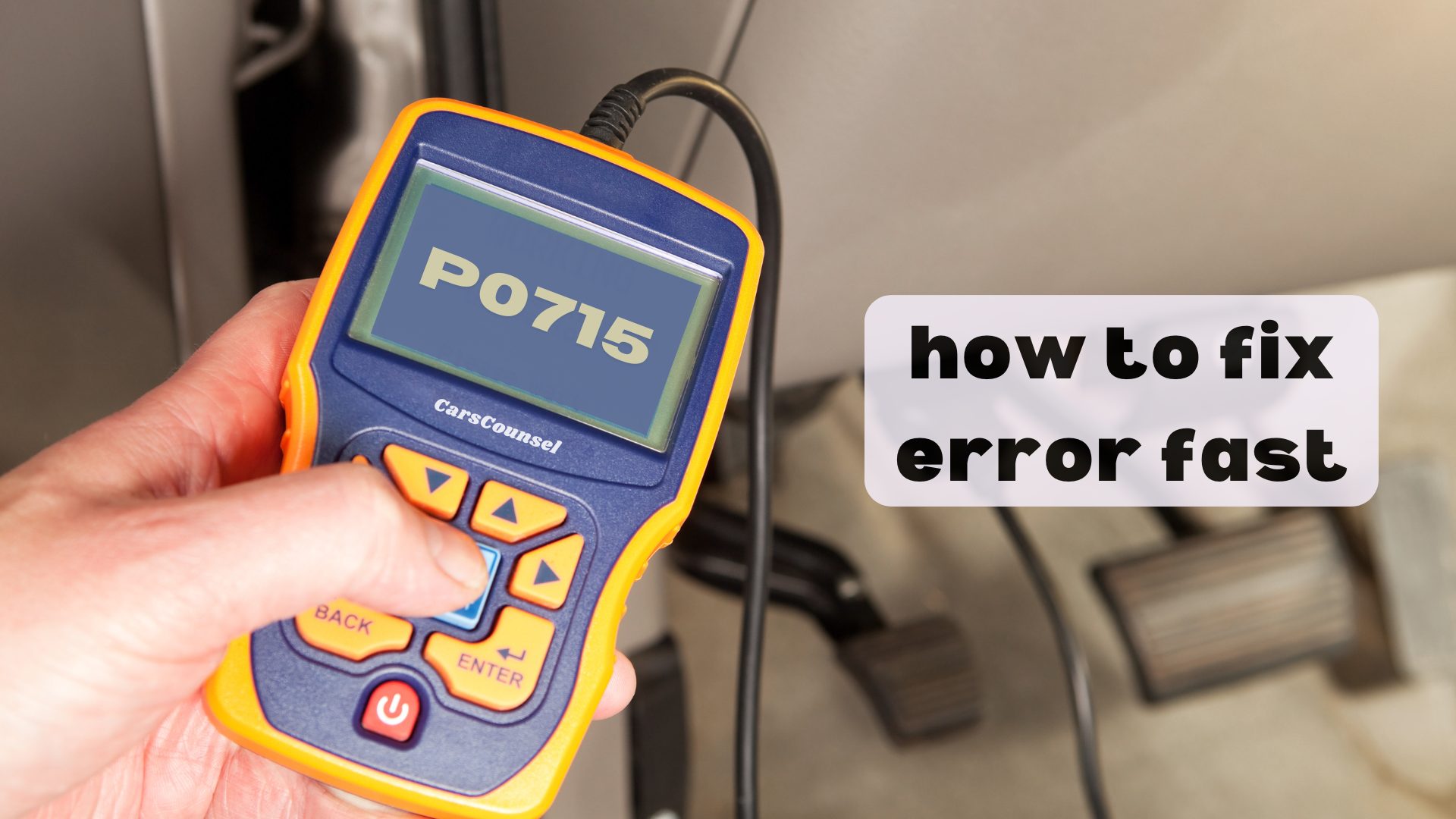You’re driving when the check engine light suddenly comes on, and your scanner shows a P0715 code.
This code usually means there’s an issue with the input speed sensor, but don’t worry just yet.
Start by looking at the sensor for any visible damage or wear, and use a multimeter to check its resistance.
Also, inspect the wiring and connectors for any signs of fraying or corrosion.
These steps can help you quickly find and fix the problem.
Want to know about other possible causes and solutions to get back on the road faster?

Quick Navigation
Key Takeaways
- Check the input speed sensor and replace it if it doesn’t pass the electrical resistance tests.
- Look for and fix any damaged or worn-out wires and connectors that might be messing up the sensor signal.
- Make sure the transmission fluid is clean and at the right level; change it if it’s dirty.
- Use a diagnostic scanner to clear the error codes after making repairs to ensure the problem is fixed.
Understanding the P0715 Code
Understanding the P0715 code which in fact is part of all OBD2 Codes is important because it signals a problem with the input/turbine speed sensor in your car’s transmission system. This sensor keeps track of the input shaft speed and sends this information to the Engine Control Module (ECM) to ensure the transmission works efficiently.
If the sensor fails, the P0715 code is triggered, which can mess up the sensor’s job and affect how the transmission and gear shifting work. This can cause your car to shift gears unpredictably and lower your fuel efficiency.
Fixing this issue quickly is crucial for keeping your transmission running smoothly. Diagnostic tests can find the problems detected by the Transmission Control Module (TCM), helping you fix the issue and get your car running well again.
Common Causes of P0715
Several things can cause the P0715 code, mainly involving problems with the input speed sensor and its related parts. A bad input speed sensor often needs to be replaced to work correctly again.
Damaged wiring can also mess up the sensor’s signals, so fixing the wiring is important for proper communication with the ECM.
Debris in the transmission fluid can also impact the sensor’s performance.
Although it’s less common, issues with the TCM might mistakenly point to sensor problems.
Mechanical problems in the transmission can also trigger this error code.
Fixing these issues quickly by replacing the sensor and repairing the wiring is crucial to keeping your transmission running smoothly and preventing more damage.
Symptoms to Watch For
Symptoms to Watch For
When dealing with the P0715 code, keep an eye out for problems like rough gear changes and sluggish acceleration. These signs are important for understanding how serious the issue is and for using the right troubleshooting steps. Also, check for warning lights on the dashboard, as they can indicate transmission problems.
| Symptoms | Severity Level | Troubleshooting Steps |
|---|---|---|
| Rough gear changes | High | Check the sensor and transmission |
| Sluggish acceleration | High | Inspect the sensor, wiring, and fluid |
| Warning lights | Medium | Use an OBD-II scanner to read codes |
| Reduced fuel efficiency | Medium | Check the sensor and overall system |
| No noticeable problems | Low | Do regular diagnostic checks |
Act quickly to address these symptoms and avoid further damage. Use diagnostic tools and visual checks to accurately find and fix the issue.
Impact on Vehicle Models
The P0715 code can cause problems in certain car models, and it’s important to know which ones are most often affected and how it impacts their performance. This code usually shows up in the following models:
- Ford Focus: This model has design flaws in its 4F27E transmission, leading to frequent transmission problems.
- Ford Fiesta: It faces similar transmission issues as the Focus, affecting how it shifts gears and accelerates.
- Mazda 5: Manufacturing flaws make this model prone to harsh shifting and poor performance.
Knowing that these models are likely to have the P0715 code can help you watch out for potential transmission issues.
If you own one of these cars, keep an eye out for signs like rough shifting and slow acceleration.
Fixing the P0715 code quickly can stop more severe transmission damage and save you from expensive repairs.
Driving With the P0715 Code
Driving with the P0715 code isn’t a good idea because it can make transmission problems worse and lead to higher repair costs.
Although it might seem like you can drive safely, a bad input speed sensor can cause irregular shifting and poor acceleration, making it harder to control your vehicle.
Simple fixes, like checking and refilling transmission fluid, might help with some symptoms but won’t solve the main problem.
Avoid carrying heavy loads and driving aggressively to reduce stress on the transmission.
Ignoring the P0715 code can turn small issues into bigger, more expensive ones. It’s important to find and fix the root cause to keep your vehicle safe and running well.
Diagnostic Tools and Methods
To fix the P0715 code, you’ll need some specific tools and methods to find the exact problem. Start by using a good diagnostic scanner to read the error code and get detailed information.
- Diagnostic Scanners: These tools are crucial for getting and understanding error codes from your car’s computer.
- Troubleshooting Techniques: Look at the wiring and connectors to see if there’s any corrosion, damage, or loose connections.
- Visual Inspections: Check the transmission fluid level and make sure it’s clean and not contaminated.
Inspecting the Input Speed Sensor
Start by finding the input speed sensor, which is usually on the transmission housing, to start your inspection.
Look over the sensor for any physical damage or signs of wear. Make sure the sensor is securely attached and clean.
Use a multimeter to check the sensor’s electrical resistance and compare it to what the manufacturer says it should be.
If the sensor doesn’t pass these checks, think about replacing it.
Carefully remove the old sensor and put in a new one that matches. Be sure to follow the torque specifications when tightening the new sensor.
After replacing the sensor, use an OBD-II scanner to clear any fault codes, and take the vehicle for a test drive to make sure the problem is fixed.
Checking Wiring and Connections
After checking the input speed sensor, look at the wiring and connections for any damage or rust that might mess with the sensor’s signals to the ECM. It’s really important to make sure the wiring and connections are in good shape.
Here’s what to look for:
- Frayed or broken wires: See if there are any visible cuts or breaks in the wiring.
- Corroded connectors: Clean or replace any connectors that show signs of rust to ensure they connect properly.
- Loose connections: Tighten any loose connectors to avoid problems with the sensor’s signals.
Evaluating Transmission Fluid
Checking your transmission fluid is important to make sure it’s in good shape and at the right level, which helps keep your transmission working well and sensors functioning properly. Here’s how to do it:
- Find the transmission dipstick. Make sure your car is on flat ground.
- Pull out the dipstick, wipe it clean, put it back in, then pull it out again to check the fluid level.
- The fluid should be clean and reddish. If it smells burnt or looks dark, it means the fluid quality is bad.
Here’s a quick guide:
| What to Check | Good Condition | Bad Condition |
|---|---|---|
| Color | Reddish | Dark or Brown |
| Smell | Neutral | Burnt |
| Level | Full (within marks) | Low or Too Much |
| Feel | Smooth | Gritty or Debris Present |
Keeping your transmission fluid in good condition helps avoid problems and ensures your car runs smoothly.
Repair and Maintenance Tips
To keep your transmission in great shape, regularly check important parts like the input speed sensor and wiring. Doing regular maintenance helps your transmission last longer and work smoothly.
Here are three simple tips:
- Regular Checks: Look at the input speed sensor and wiring often to spot any wear or damage early.
- Check the Fluid: Keep an eye on the transmission fluid and change it when needed. Clean fluid helps prevent problems.
- Lighten the Load: Try not to tow heavy loads or drive in extreme conditions, as this can wear out the transmission faster.
More OBD-II Codes
Frequently Asked Questions
Can a P0715 Code Cause Long-Term Transmission Damage?
Yes, a P0715 code can cause long-term damage to your transmission if you ignore it. Bad transmission sensors can mess up how your car runs. Use diagnostic tools to find and fix the problem quickly to avoid more damage and expensive repairs.
What Are the Costs Associated With Fixing a P0715 Code?
Fixing a P0715 code usually costs between $100 and $400, including the diagnostic fees. The final price can vary depending on whether you need to replace a sensor, fix some wiring, or deal with issues in the transmission control module (TCM). Getting an accurate diagnosis ensures you fix the real problem without spending extra money.
Are DIY Repairs Possible for the P0715 Code?
You can try fixing it yourself. Start by checking the wiring and connectors. If necessary, replace the input speed sensor. With some basic skills, you can save money on repairs. Just take your time and be careful.
How Do I Prevent the P0715 Code From Recurring?
To keep the P0715 code from coming back, focus on regular maintenance. Change your transmission fluid on schedule, check the system often, and avoid harsh driving. These simple steps help keep your transmission in good shape and lower the chances of sensor problems.
Can Software Updates Resolve a P0715 Code Issue?
Don’t worry, sometimes software updates can fix P0715 issues by making the software work better with the transmission sensors. However, they’re not always a sure fix. Make sure to also check for any sensor issues or wiring problems to fully address the problem.
Conclusion
To sum up, it’s crucial to fix the P0715 code quickly to keep your transmission in good shape.
Did you know that 30% of transmission failures are due to sensor problems?
By checking the input speed sensor, looking at the wiring and connections, and assessing the transmission fluid, you can quickly find and fix the issue.
Don’t skip these steps—repairing or replacing faulty parts ensures your vehicle stays in top condition.
Stay proactive, and your transmission will keep running smoothly.

